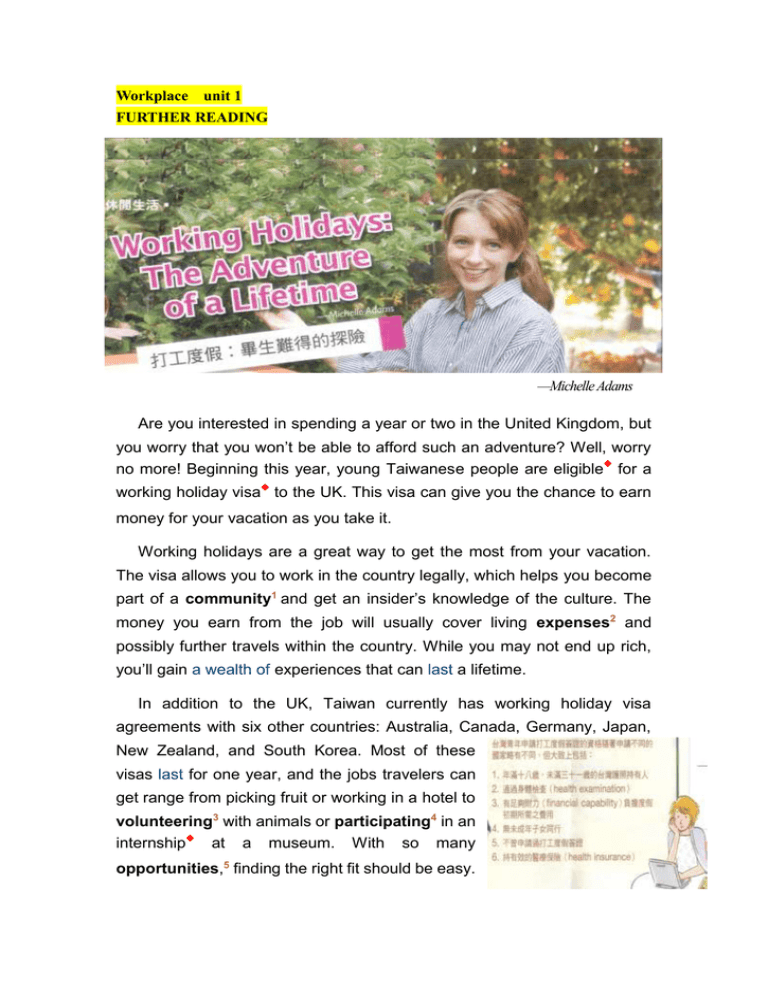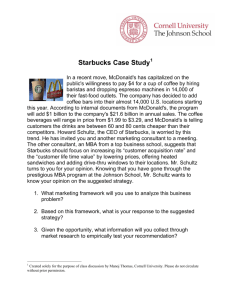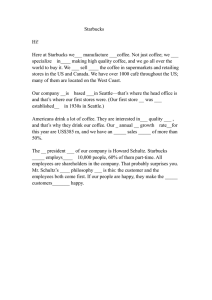Workplace unit 1 FURTHER READING —Michelle Adams
advertisement

Workplace unit 1 FURTHER READING —Michelle Adams Are you interested in spending a year or two in the United Kingdom, but you worry that you won’t be able to afford such an adventure? Well, worry ◆ no more! Beginning this year, young Taiwanese people are eligible for a ◆ working holiday visa to the UK. This visa can give you the chance to earn money for your vacation as you take it. Working holidays are a great way to get the most from your vacation. The visa allows you to work in the country legally, which helps you become part of a community1 and get an insider’s knowledge of the culture. The money you earn from the job will usually cover living expenses2 and possibly further travels within the country. While you may not end up rich, you’ll gain a wealth of experiences that can last a lifetime. In addition to the UK, Taiwan currently has working holiday visa agreements with six other countries: Australia, Canada, Germany, Japan, New Zealand, and South Korea. Most of these visas last for one year, and the jobs travelers can get range from picking fruit or working in a hotel to volunteering3 with animals or participating4 in an ◆ internship at a museum. With so many opportunities,5 finding the right fit should be easy. Working holidays help young people learn independence and make friends around the world, all the while adding something special to their ◆ résumé. However, a successful working holiday requires a lot of planning. After you’ve chosen your ◆ destination, it’s a good idea to brush up on your language skills. In addition, ◆ check out the working visa forums so you can read accounts1 of real experiences. This will help you prepare for the best and the worst that could happen. It’s also wise to have extra funds2 and insurance3 as a safety net. In an emergency situation abroad, the last thing you will want to worry about is money. Once you’ve made it to your working holiday country, all may not be smooth sailing. Don’t let a little rough water send you running for home, though. homesickness, Culture and shock, challenges should be expected and are part of the living abroad experience. You might want to join online groups for your destination country before you even leave home. In this way, you can build a network4 of friends that will support you during the initial5 ◆ difficult transition. Are you ready for your working holiday? By taking the right steps and having a positive attitude, you can turn a vacation into the adventure of a lifetime. LESSON 2 Job Interview FURTHER READING The Innovative Genius of Steve Jobs There is a short list of people who are famous for ushering in the age of personal computing. On the top of that list is Steve Jobs, one of the cofounders* of Apple. He is known for his innovation, and his companies and products have changed the way people work as well as play. Jobs did not follow the normal route to success. After attending Reed College for only one semester in the early 1970s, he dropped out and audited2 classes instead. This decision left him free to take classes that interested him. One class he audited was calligraphy,* which he credits3 as the reason why computers today have so many beautiful fonts* available. In 1976, when Jobs was 21 years old, his odyssey in the computer world began in his parents’ garage. Along with his close friend, computer guru* Steve Wozniak, Apple Computer Company was born. With Wozniak’s design, Jobs’s marketing genius, and $250,000 from an investor,4 Apple became a multimillion-dollar company in the course of a few short years. Jobs’s vision of bringing digital5 technology to the masses would eventually transform6 the world. Known for his demanding7 personality, Steve Jobs is considered Silicon Valley’s* original enfant terrible.* He had always been a “doer,” and his eagerness was often taken as arrogance.* After he grew Apple computer from a two-man team to a 4000-employee company, in 1985, he found himself out of a job. The company’s board8 saw him as too much of a risk, so he was stripped of his power. Although the events in 1985 were a major blow9 to him, Jobs knew he wasn’t finished in the computer industry. Over the next decade he formed NeXT, a technology company whose software and hardware were used to create the first World Wide Web server. He also bought a computer animation* company he renamed Pixar Animation, which gave the world the first computer animated film, Toy Story, in 1995. A surprising turn of events came about in 1996. Apple, after years of financial10 losses and layoffs, 11 decided to buy NeXT. Twenty years after cofounding the company, Jobs was once again part of Apple. As he took the helm, he rebuilt the company into the powerhouse* of innovation that introduced the iMac, iPod, and iPhone. Within a few years, the struggling company recovered and is now more profitable12 than ever. In 2004, Steve Jobs was diagnosed with pancreatic* cancer, but it was successfully operated on, and the tumor* was removed.13 However, this worried Apple investors and clients,14 for the charismatic* Jobs is often viewed as the heart and soul of the company. When Jobs gave the commencement* address15 at Stanford University a year after his illness, he described how the disease had changed his life. He also spoke about his career, saying that he was lucky to have found what he loved to do early in life. He said, “Your work is going to fill a large part of your life, and the only way to be truly satisfied is to do what you believe is great work. And the only way to do great work is to love what you do.” If there are words that characterize16 Steve Jobs’s world view, they are probably best found in the advice he gave to end his speech at Stanford. He took the words from the last edition of the Whole Earth Catalog17 from the 1970s. He loved the advice then and still lives by it today. For the graduating class, he wished them the four simple words that were found on the catalog’s back cover: “Stay hungry. Stay foolish.” LESSON 3 The First Day of Work FURTHER READING In so many ways, social skills -- or lack thereof-- impact on our professional and private lives. The good news is that even if your social skills leave something to be desired, there are surefire ways to improve them and raise your EQ in the process. Learn to Listen Most of us are too preoccupied with our own lives to pay adequate attention to what others are telling us. However, by not listening intently enough, you convey the message that the other person isn't important to you. The key is to stop focusing on yourself. Putting that energy instead into absorbing as much as you can from others will pay dividends. Find out What the Other Person Is Most into One thing that holds people back from being a social butterfly is the fear they won't be able to sustain a conversation with a stranger. If this describes you, here's one thing you should keep in mind: People love to gab about the things they are interested in. All you need to do is to tune into their main interests. The rest will then fall into place. Tone down Your Criticism Being a "negative Nelly" won't win you too many friends, especially if you target others with your negative attitude. People are drawn to optimistic people; pessimism often makes others uncomfortable. Look for the positive in the situation. While being a good listener, discovering a person's interests and biting your critical tongue are valuable pointers, there is much more to building up your social skills. Here are some more tips. Avoid Arguments Like the Plague Although venting your anger and frustration in an argument may be tempting at times, it's best not to give in to the urge to blow your top. You can't win an argument. You may have logic on your side, but damaging other people's feelings during a verbal joust is not a sign that you've mastered good social skills. Bone up on Your Body Language You've probably heard that the vast majority of what you communicate to others is nonverbal. Given this, it only makes sense to be on the ball with regard to how your tone of voice and body language act to create an impression. Remember the Golden Rule Treat people as you would want to be treated. You don't have to be religious to follow this famous rule found in the Bible and elsewhere. It's just common sense. If you are less than thrilled by your social skills, give these tips a try. You might be surprised at how effective they can be in both your social life and your worklife. LESSON 4 Telephone Conversations FURTHER READING When Howard Schultz established Starbucks in the 1980s, he reinvented the coffee experience, offering gourmet coffees and a special relationship with customers. Two decades later, in dire need, the company called him back to reinvent that experience again. 當霍華蕭茲在西元 1980 年建立了星巴克,他重新塑造了咖 啡體驗,提供美味的咖啡與顧客們的特別關係。二十年後, 在迫切需要下,公司請他回去再次塑造體驗。 In 2007, Starbucks was struggling, a victim of both the bad economy and its own rapid growth. Expansion over the previous three years had doubled the number of locations to more than 16,000. In the process, many people felt the company had commodified its business, watering down its special coffee experience. 在 2007 年 ,星巴克掙扎,成了經濟不景氣和自身快速成長 下的受害者。前三年的擴展,門市增加到 16,000 家。在這過程中,很多人認為這 間公司已商品化了,淡化了他特別的咖啡體驗。 What's more, chains including McDonald's were entering the gourmet coffee market, offering new competition. 此外,包含麥當勞等連鎖業也進入了咖啡市場,引發新的競爭。 Starbucks shares fell from US$38 in late 2006 to US$18.11 at the end of 2007 and would continue to slide to a low of less than US$10 at the height of the recession. So in early 2008 the company's board asked Schultz, who was then board chairman, to return as CEO, eight years after leaving the job. 星巴克的股價重 2006 年底的 38 塊美金跌至 2007 年底的 18.11 塊美金,在經濟 衰退最高點時可能持續下降到低於 10 塊美金。所以在 2008 年初公司董事會請當 時在擔任董事長的蕭茲重任執行長,這個離開八年的工作。 After talking with his family -- being CEO would entail 15-hour days -- Schultz finally agreed. Assuming the reins, he announced a "transformation agenda" to revive the company's fortunes. 做為執行長一天工作時間需要 15 個小時,和家人討論後蕭茲最後答應了。取得 大權後他宣布"轉型計劃"重振公司的命運。 "We must address the challenges we face and we know what has to be done," Schultz said. "We are recommitting ourselves to what has made Starbucks and the Starbucks experience so unique." "我們必須正視我們面臨的挑戰,我們知道該怎麼做"蕭茲說"我們重新致力於找 回星巴克與星巴克獨特的體驗" Beginning in January 2008, Schultz announced a series of changes. The company named several new top executives, cut hundreds of jobs, and slowed the pace of store openings. 從 2008 年 1 月開始,蕭茲宣布一系列的改變。公司命名一些新的高層管理人員, 削減數百個職位並減慢了開新店的步伐。 More important, Schultz sought ways to improve the coffee experience. He introduced new coffee machines, changed how coffee was brewed, and started a customer rewards program. At one point he even ordered all 7,100 Starbucks stores in the United States to close at 5:30 p.m. on a Tuesday to give new training to 135,000 staff. Schultz also turned to technology, introducing limited free Wi-Fi in stores and launching a social media strategy. Today, Starbucks has over 24 million Likes on its Facebook page, which is regularly updated with special offers and rewards for loyal fans. 更重要的是,蕭茲尋找方法以改善咖啡體驗。他引入了新的咖啡機器,改變了怎 麼釀造咖啡並開始顧客獎勵企劃。有一次他甚至命令在美國全部 7,100 家星巴克 在下午 5 點 30 分關閉在星期二給 135,000 員工新的訓練。蕭茲也轉向技術,引 進有限的無線網路在商店並推出社交媒體戰略。今天,星巴克在它的 Facebook 頁面有超過 24 百萬人喜歡,並定期更新特別的優惠和獎勵給忠實的粉絲們。 After two years of restructuring and weathering the recession, Starbucks appears to be back on track. For the fiscal year in 2010, the company's net income more than doubled to US$945.6 million from the previous year. Starbucks' stock has also rebounded, climbing to more than US$35 per share. 在兩年的重組和經濟衰退後,星巴克似乎回到了正軌。2010 年財政年度公司的 淨收入比去年 945.6 百萬美金增加了一倍。星巴克的股價也出現反彈,爬升每股 超過 35 美元。 Schultz was always confident that things could be turned around. As he began charting the comeback in March 2008, he told the annual shareholders meeting: "There have been times in our history where others questioned whether we had reached our limit. Yet time and time again, we have responded by reaching even greater heights." 蕭茲總是相信事情可以有反轉。當他開始指明了在 2008 年 3 月復出,他年度股 東大會上說:"在我們的歷史上曾經有段時間在別人質疑我們是否已經達到了我 們的極限,然而一次又一次,我們已作出回應,達到更高的水平。" LES SO N 5 Meetings FURTHER READING The name Zara was well known to shoppers in Taiwan long before it opened its flagship Taipei store last November. The 36-year-old Spanish retailer has been described by Louis Vuitton fashion director Daniel Piette as "possibly the most innovative and devastating retailer in the world." What's all the fuss about? Zara's success is down to maverick entrepreneur Amancio Ortega, who founded the company in 1975. With an estimated worth of around US$31 billion, he is now one of the world's richest men. Ortega has succeeded through strategies that fly in the face of conventional wisdom, using a customer-oriented approach that follows rather than predicts trends. On the shop floor, sales teams with PDAs solicit customer feedback, asking shoppers what they like, what they think could be improved and what they would like to see more of. This information is cross-checked with points-of-sale rankings and trends in unsold stock, which informs the restocking and style planning processes. An early exponent of fast fashion, Zara replenishes stores worldwide twice weekly, using quick turnover to drive demand. The company famously needs just two weeks to move a product from development to shelves. This is aided by vertical integration, which sees Zara controlling the supply chain. Meanwhile, high air transportation and labor costs are offset by a severely-reduced advertising budget. As with fast fashion rivals Uniqlo and H&M, overseas expansion has been crucial to Zara's success. However, while Zara's parent Inditex saw net income increase 14 percent for the first half of 2011, Uniqlo's profits dropped 11.9 percent and H&M's 15.4 percent. At the same time, Zara posted net sales growth of 12 percent against a marginal increase of 0.7 percent for Uniqlo and 2.2 percent for H&M. It hasn't all been a walk in the park for Zara. A number of challenges cropped up in 2011 including criticism from the Beijing Consumers Association, which cited color defects and false claims on labels about the quality of materials. There is also the threat of litigation from luxury brands who feel fast fashion retailers are overstepping the mark with their knockoff designs. Most recently, there was controversy over one of Zara's suppliers in Brazil, which was accused of running a sweatshop that kept Bolivian workers in virtual slavery. Despite these concerns, Zara is thriving. The biggest challenge may be how to maintain momentum rather than how to keep competitors like Uniqlo, Gap and H&M at bay. With rising labor and transportation costs and increasingly complicated logistics, Zara will need to be at its innovative best to keep things ticking along.



